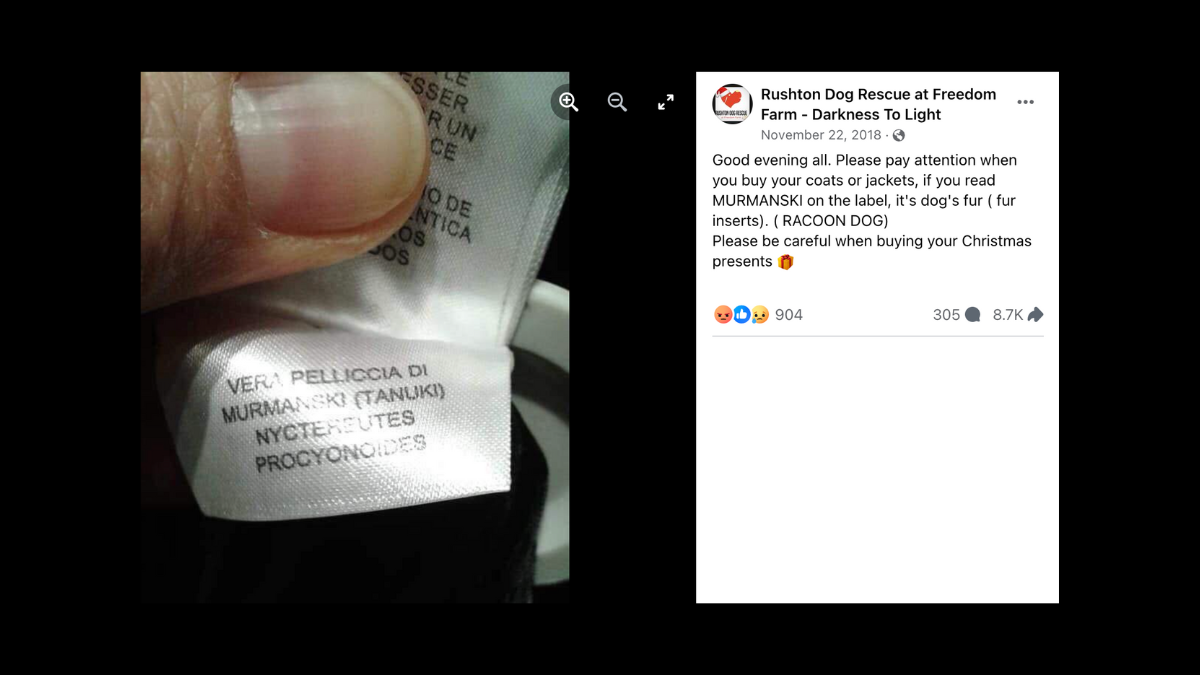A photograph that purportedly showed the words “MURMANSKI (TANUKI)” listed on clothing tags was shared on Facebook by Rushton Dog Rescue, an animal shelter and registered charity in the United Kingdom, on Nov. 22, 2018 (archive). A caption that accompanied the post suggested that these labels referred to dog fur:
Visible at the bottom of the tag is a label that read “Nyctereutes procyonoides,” the scientific name for an animal commonly known as the raccoon dog.
Both “Murmanski” and “Tanuki” are common terms for raccoon dogs, which are neither dogs nor raccoons, though they are considered a member of Canidae, a biological family of dogs and dog-like mammals that includes dogs, wolves, and foxes, among other species. Members of this family are also called canids. (It’s thought by many that raccoon dogs are likely most closely related to foxes or badgers.)
Fur labeling requirements in the U.S. are overseen by the Federal Trade Commission (FTC), which requires that any fur derived from raccoon dogs be labeled, “Asiatic raccoon.” Snopes found no reference to “Murmanski” or “Tanuki” in the FTC Fur Products Name Guide, which lists the animals whose fur could be used in a garment, current as of Dec. 6, 2023 (archive). The guide was last updated in 2014.
However, “Murmanski” or “Tanuki” may be used by other countries regulated by different labeling authorities and requirements.
Tracing the Claim
Awareness was brought to the trade in part by animal photojournalist Jo-Anne McArthur, whose work was posted to Instagram by the Natural History Museum Wildlife Photographer of the Year account on Feb. 20, 2023. McArthur wrote:
Many of us haven’t heard of raccoon dogs.
They are part of the canid family, and native to East Asia. They have been farmed for their fur for over a century, and on labels, you might see the fur listed as “murmanski”, “tanuki”, “Asiatic” or “Finn” raccoon. In several widely publicized incidents, faux or fake fur has been revealed to be that of raccoon dog.
The photo above was captured in 2012 and included as part of a project by documenting raccoon dog farming. For background, Murmansk is a city in Russia, and in Japanese folklore, Tanuki is known as a trickster.
Is the Raccoon Dog Genuinely Considered a Dog?
Raccoon dogs are not true dogs, so to speak, but are considered a related taxa. It’s thought by many that raccoon dogs are likely most closely related to foxes or badgers. They are native to the forests of eastern Siberia, northern China, North Vietnam, Korea and Japan.
There are two species of raccoon dog, the common raccoon dog (Nyctereutes procyonoides) and the Japanese raccoon dog (Nyctereutes viverrinus). Both are small and fox-like in stature with dense fur markings similar to raccoons. With rounded, short ears and thick bushy tails, raccoon dogs are predated upon by wolves, links, wolverines, and eagles in the wild. But humans are the animal’s most dangerous predator.
The International Union of the Conservation of Nature Canid Specialist Group reported that Russians introduced raccoon dogs in the wild in Eastern Europe to establish a new fur trade. Today, the animals are largely produced in fur farms and hunted by some European nations.
Humane Society International (HSI) reported that in 2019 13.5 million raccoon dogs were reared in China for fur production. Historically, raccoon dog fur has been found in genuine fur products and mislabeled as “faux fur.”
Under the U.S. Customs and Border Protection, it is illegal to import, export, sell, or advertise domestic dog fur, and fur from other animals, including raccoon dogs, must be identified and labeled only if the value exceeds $150.
Labeling Requirements in the US
Under the Fur Products Labeling Act, articles of apparel made of fur must be labeled and advertised, among other things, with the true English name of the animal from which the fur was taken.
The FTC Fur Products Name Guide, which lists the animals whose fur could be used in a garment, was last reviewed in 2014, at which point some commentators petitioned that the agency update its definition of “Asiatic raccoon” to more accurately reflect its canine lineage. However, the FTC ruled to continue to describe the species as the “Asiatic Raccoons,” arguing that the term “best identifies this animal for fur consumers” adding that “‘Raccoon Dog’ would mislead consumers.”
In short, as of this publication, fur derived from raccoon dogs must be labeled, “Asiatic raccoon.” Snopes found no references in the FTC guide to “Murmanski” or “Tanuki,” current as of Dec. 6, 2023 (archive).
However, “Murmanski” or “Tanuki” may be used by other countries regulated by different labeling authorities and requirements.
